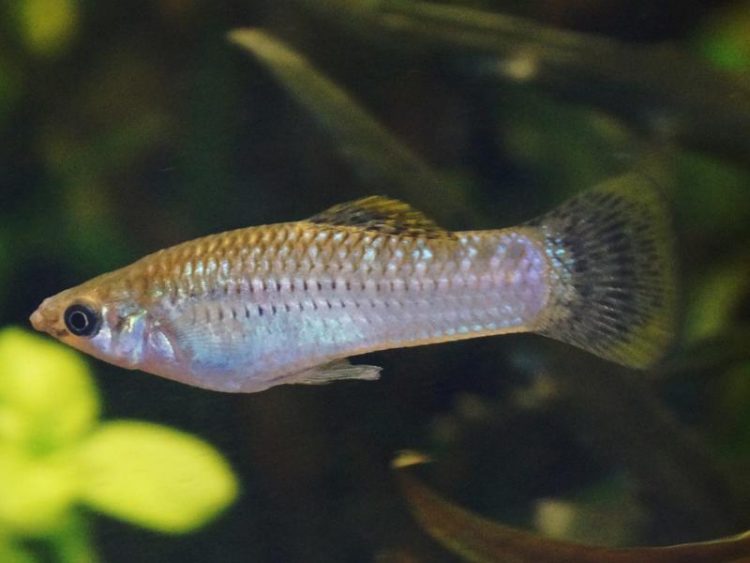A tale of survival – scientists reveals how fish were able to colonise poisonous springs

Poecilia mexicana Copyright: M. Pfenninger
However populations of shortfin molly fish managed to colonise springs with high concentrations of dissolved hydrogen sulphide. In a new study researchers from LOEWE Biodiversity and Climate Research Centre (BiK-F) and the Goethe University Frankfurt am Main present evidence of genetic changes minimizing the harmful effects of H2S which enable the fish to survive in this deleterious environment.
The study provides insight into the molecular mechanisms of this key adaptation for the first time. It is published online today in “Nature Communications”.
Shortfin molly fishes (Poecilia mexicana) may only measure a few inches, but they are still exceptional. Populations of Poecilia mexicana, whose relatives are the well-known guppy, colonised sulphide-rich volcanic springs in Southern Mexico. In making this particular habitat their home, they have made the impossible possible, because hydrogen sulphide (H2S), as for many other animal, is lethal. Even at low concentrations the gas blocks the cytochrome c oxidase-complex (COX). The higher the level of hydrogen sulphide, the more the activity of COX is inhibited. As it is essential for respiration, this turns out to be lethal in the end.
Changes in genetic make-up make less susceptible to poison
A team led by Prof. Dr. Markus Pfenninger, LOEWE Biodiversity and Climate Research Centre (BiK-F) and PD Dr. Martin Plath, Goethe University, has taken a closer look at the survivors. Their analysis showed that the COX activity of individuals of shortfin molly fish which colonise H2S-rich waters remains virtually unchanged under high H2S concentrations. This is due to a number of changes in the cox1 and cox3 genes, which have only occurred in populations living in the poisonous springs. Thus, transplanting individuals from non-sulphidic habitat to springs with high H2S levels kills them for sure.
Molecular mechanisms of adaptation to extreme habitat
“In this paper we analyse the key adaptation to an extreme habitat up to its molecular basis at the level of amino acids. This way, for the first time, we are able to point out, where exactly the adaption has taken place.” Pfenninger concludes. The team also modelled three dimensional protein structures in order to shed light on necessary significant structural changes of amino acids in the cox1 gene. Without these structural changes, the colonisation of the H2S-containing water for the fish would have been impossible. By colonising the poisonous springs, where there are hardly any other competitors, the fish may feed on resistant midge larvae that also occur there.
Closely related fish follow different paths to adaptation
The study also shows that closely related populations of a species follow parallel as well as disparate paths in response to similar environmental conditions. Three shortfin molly fish populations were sampled for study. Two of the populations show the same changes in their genetic material in adapting to the hostile conditions. However this proved to be not the case for the third population of shortfin molly fish. Whereas these fish also tolerate high levels hydrogen sulphide, the mechanism enabling their adaptation is still subject to ongoing research.
Paper:
Pfenninger, M. et al.: Parallel evolution of cox-genes in H2S- tolerant fish as key adaptation to a toxic environment – Nature Communications, DOI: 10.1038/ncomms4873
For more information please contact:
Prof. Dr. Markus Pfenninger
Goethe University &
LOEWE Biodiversity and Climate Research Centre (BiK-F)
Tel. +49 (0)69 7542 1841
Pfenninger@bio.uni-frankfurt.de
or
Sabine Wendler
LOEWE Biodiversity and Climate Research Centre (BiK-F)
Press officer
Tel. +49 (0)69 7542 1838
Sabine.wendler@senckenberg.de
LOEWE Biodiversity and Climate Research Centre, Frankfurt am Main, Germany
With the objective of analysis the complex interactions between biodiversity and climate through a wide range of methods, the Biodiversität und Klima Forschungszentrum [Biodiversity and Climate Research Centre] (BiK‐F) has been funded since 2008 within the context of the Landes‐ Offensive zur Entwicklung Wissenschaftlichökonomischer Exzellenz (LOEWE) of the Land of Hessen. The Senckenberg Gesellschaft für Naturforschung and Goethe University in Frankfurt as well as other, directly involved partners, co‐operate closely with regional, national and international institutions in the fields of science, resource and environmental management, in order to develop projections for the future and scientific recommendations for sustainable action.
For further details, please visit www.bik‐f.de
Media Contact
All latest news from the category: Life Sciences and Chemistry
Articles and reports from the Life Sciences and chemistry area deal with applied and basic research into modern biology, chemistry and human medicine.
Valuable information can be found on a range of life sciences fields including bacteriology, biochemistry, bionics, bioinformatics, biophysics, biotechnology, genetics, geobotany, human biology, marine biology, microbiology, molecular biology, cellular biology, zoology, bioinorganic chemistry, microchemistry and environmental chemistry.
Newest articles

Silicon Carbide Innovation Alliance to drive industrial-scale semiconductor work
Known for its ability to withstand extreme environments and high voltages, silicon carbide (SiC) is a semiconducting material made up of silicon and carbon atoms arranged into crystals that is…

New SPECT/CT technique shows impressive biomarker identification
…offers increased access for prostate cancer patients. A novel SPECT/CT acquisition method can accurately detect radiopharmaceutical biodistribution in a convenient manner for prostate cancer patients, opening the door for more…

How 3D printers can give robots a soft touch
Soft skin coverings and touch sensors have emerged as a promising feature for robots that are both safer and more intuitive for human interaction, but they are expensive and difficult…





















